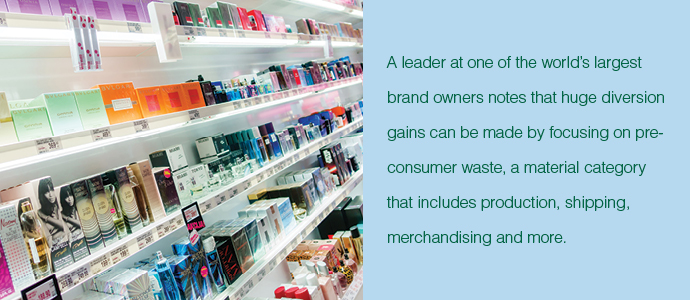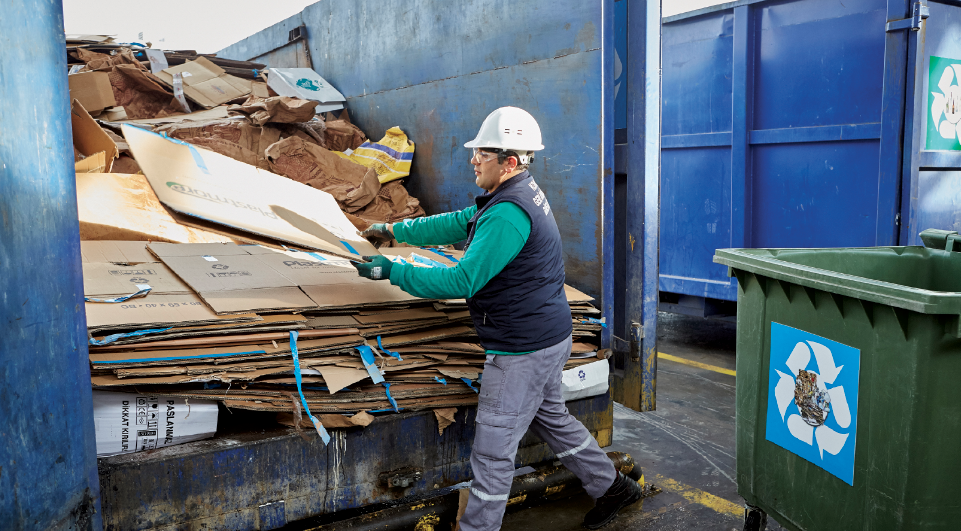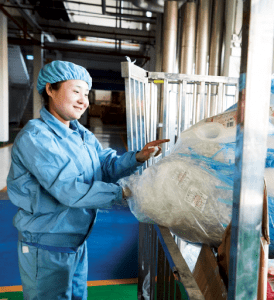
This article originally appeared in the June 2019 issue of Resource Recycling. Subscribe today for access to all print content.
The following is an excerpt from “The Future of Packaging: From Linear to Circular,” published earlier this year by Berrett-Koehler Publishers. The book was put together by Tom Szaky, founder and CEO of waste solutions company TerraCycle, and it features chapters from 15 innovators in sustainability, including Unilever’s Tony Dunnage.
Excessive packaging for products and e-commerce is something consumers notice and have been quick to criticize. There is a focus on the packaging waste they see and interact with, called post-consumer waste. But there’s more, as a significant amount of packaging and manufacturing waste is generated before a product reaches shelves – and in greater volumes and varieties than people realize.
This waste stream, known as pre-consumer waste, is defined as material produced during the manufacturing process but that does not make it into the final product. This includes but is not limited to:
- Packaging and wrappings used in the transport of raw materials from supplier to manufacturer.
- Trimmings and extras from primary, secondary and tertiary packaging or product manufacture.
- Shipping and pallet waste from the transport of products and packaging from manufacturer to distribution center to retailers.
Through this lens one can also consider products and packaging ordered in overstock, damaged, printed with out-of-date artwork, or returned to be pre-consumer waste. In addition, point-of-sale (POS) material (such as in-store signage) and secondary packaging (for instance, a crate for soda or a case of boxes of cereal) also fall into this category.
Pre-consumer waste is frequently overlooked during packaging design, and it often ends up in the landfill or incinerator due to the costs of reintegrating it into the supply chain.
Producers and manufacturers should be responsible for the end-of-life of packaging and what happens to it after consumers are finished. In the case of pre-consumer waste, there is even less room for attempting to push this responsibility downstream, as this material is still within the control of the factory, transport and retail systems. Producers invest time and money into these systems, so it makes sense that they would retain accountability for their operations, including the management of their surplus and waste material.
With little economic incentive to account for these items and a lack of regulations compelling them to do otherwise, however, producers and manufacturers often remove themselves from responsibility, leaving someone else to deal with their pre-consumer waste.
For example, POS and merchandising material has no use to the manufacturer after it serves its purpose of promoting a specific product for a particular season. It’s out of date and out of style, so the retailer doesn’t want it either. Without a reclamation system to keep this material with the manufacturer, the retailer, lacking the infrastructure to handle the material, throws it in the trash. The same goes for the secondary and tertiary packaging, the shipping and pallet materials that manufacturers and distributors use to bring products to market.
Supplying such materials to other companies or reintegrating them back into the original manufacturer’s own production lines ensures that resources continue to work for producers, their customers and the planet.

Unilever notes its focus on optimized materials use and diversion equated to $234 million in annual savings.
Extensive action over a decade
In 2008, Unilever’s factories sent 140,000 metric tons of nonhazardous waste to landfill – that’s the equivalent of 2 million full waste bins, or 17 Eiffel Towers. Given what Unilever has since managed to achieve, it almost seems unreal that we have ever done things any other way. But as is the case for any company today, the first steps on the sustainability journey entailed coming to terms with the fact that the business-as-usual way of doing things was no longer working and needed to change.
In addition to an ambitious target of using 100 percent reusable, recyclable, or compostable plastic packaging by 2025, Unilever set the pivotal goal of achieving zero nonhazardous waste to landfill by 2020. Some companies regard zero-waste-to-landfill (ZWTL) as a guiding ideal rather than a benchmark, and many seek certification for visibility. At the core of these programs are continuous improvement and constant evaluation about material choices.
There is not a one-size-fits-all approach to reducing waste in manufacturing, but a strong commitment to eliminating waste at the source is the preferred place to start. Optimizing manufacturing to prevent trimmings from production prevents the need for reverse logistics, the next preferred step for resource management.
It’s also helpful to look outside one’s sector of expertise to brainstorm ways to come up with novel solutions for the business at hand.
Take textiles, for example. Optimized machines producing knitwear and sweaters in one piece, as well as cutting cloth from a pattern that keeps most of the source material intact, reduces the use of material and the need to recycle or dispose of it.
The same concepts of optimization and one-piece production can be applied to consumer packaged goods (CPGs). Unilever successfully applied weight reduction as a production tactic, which has been implemented by many other CPG companies. Less weight for a package equals less scrap potentially sent to landfill.
One condiment company, for example, reduced the size of its bottles, openings and spouts. This cut down the number of trimmings from molding the bottle, as well as the amount of wrapping material used to seal it.
The next way to eliminate waste sent to landfill is to integrate the inevitable production scrap.
Maintaining separation of materials is integral to this achievement and the expansion of reuse to other activities. One Japanese electronics and technology company developed a way to convert material from its solar panel production plant into usable powder for cement. As a result, the site’s factory waste “recycling rate” reached 93.5 percent (it is important to note that “recycling” into energy is the least favorable circular solution, though it’s better than landfilling).
For Unilever, a detailed mapping of every production site’s unique mixed waste streams was the first step to developing action plans for reuse, recycling and recovery, which were made available to all locations. This approach has meant reconsidering every single material that is consumed and encouraging transparency across operations.
Here are some initiatives that have been developed through Unilever’s efforts to make gains in the pre-consumer waste realm:
- A solution at a site in Kenya repurposes laminated wrapper waste into a versatile rigid construction material that can be formed into corrugated or flat panels for use in fencing and roofing.
- A vermicomposting process in South Asia uses worms to break down manufacturing food waste into compost, which is used to fertilize organic vegetables for staff canteens and made available to employees and local communities for use in growing their own crops.
- In a U.K. factory, raw and packaging materials are received in cardboard boxes. It has been found that the boxes can be reused by other industries directly without the need for recycling.
- In Australia, reject stock tubs are turned into fertilizer. And a partnership with an innovative waste management company recycles surplus plastics from the food-and-beverage unit into underground pipe covers and garden edging.
- In Africa and Latin America, hard-to-recycle materials are shredded and compressed at high temperatures to make school desks.
In addition, Unilever updated its pallets from single-use wood to reusable, durable plastic products that get repaired. Standardization of items such as pallets and intermediate bulk containers facilitates multiple uses and return systems that work across the industry, creating a larger infrastructure for waste reduction and reuse.
Here we ask: Why can’t this be done with other materials? Why not a collapsible plastic box? Why must secondary packaging and POS material be one-way, the energy and resources poured into them lost forever to linear disposal?
No matter what your manufacturing sector – durable or nondurable, packaged, luxury, or service-based goods – thinking about ways to get the most out of the materials you invest in will unlock possibilities at every turn.
Let’s spread the model

Zero-waste-to-landfill programs by corporate entities create jobs and can serve as inspiration for efforts across industries.
Despite the growing popularity of ZWTL in sustainability circles, many organizations still harbor the mind-set that it does nothing for the bottom line. We’ve found that quite the opposite is true.
In any realm, the early pioneers rarely take the easiest or fastest path, but like the Wright brothers and their first airplane, it takes someone to prove what is possible. The Wright brothers didn’t go the farthest, and their aircraft wasn’t the most comfortable. But by setting out to demonstrate that something new was possible, they opened the doors to innovation.
Ultimately, Unilever achieved its ZWTL goal in 2014, six years ahead of target. At that point, more than 240 factories in 67 countries reused, recycled or recovered all of their nonhazardous waste and sent nothing to landfill. Unilever’s sustainability leaders believed that the model and mind-set that drove the achievements in these factories would be repeatable beyond a manufacturing environment. So, they set out to extend this to other parts of the business.
By February 2016, nearly 400 additional Unilever sites, including offices, distribution centers and warehouses in more than 70 countries, had achieved ZWTL. This has equated to $234 million in annual savings and costs avoided (to reinvest back into the business), and the company’s waste per metric ton of production has been reduced by 37 percent compared with the 2008 baseline.
By bringing nonhazardous manufacturing waste to landfill to zero, Unilever unlocked two additional benefits of note. First, at a conservative but accountable estimate, 450 new jobs have been created for disabled and disadvantaged citizens in poorer parts of the world as a direct result of strategies for redirecting byproducts and “waste” from manufacturing to new and useful purposes.
Second, groundbreaking momentum for the business was driven with employees around the world. Shortly after the completion of these targets, Unilever held an event with competitors, peers, suppliers and partners, inviting them to join this important journey. The presentation shared details of the methodology and introduced and highlighted best practices, hoping to amplify them across the industry. By designing once and deploying everywhere, Unilever hopes to help every business find its own model for zero waste.
Sharing the model, rather than keeping it under wraps, is important for transparency, one of Unilever’s core values and an aspect of its culture. A transparent account of progress through engaging, insightful and evidence-based reporting allows the garnering of the best feedback from consumers and stakeholders to keep improving.
Tony Dunnage is group director of manufacturing sustainability at Unilever. He is based in London.

